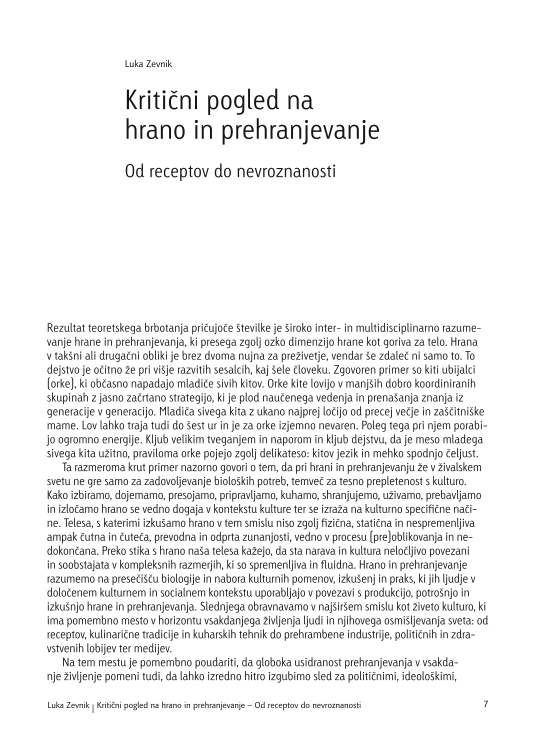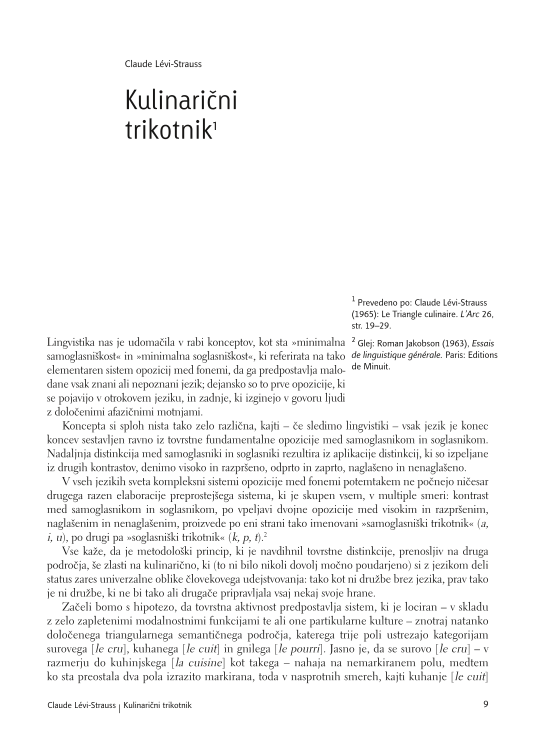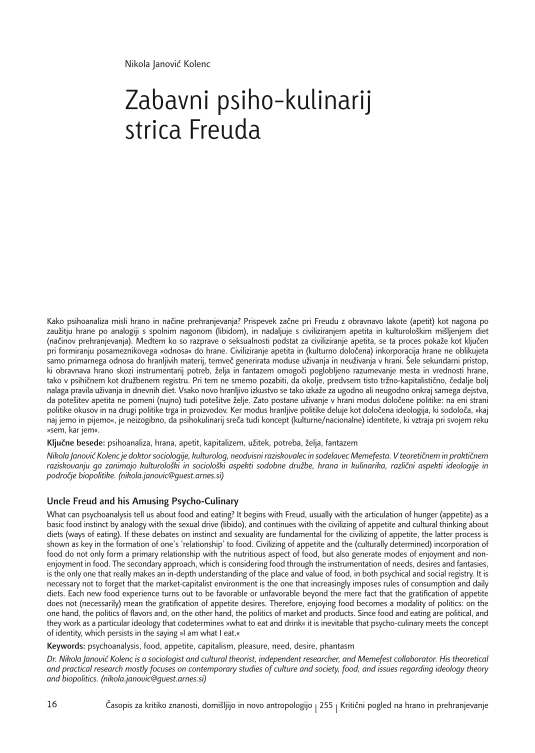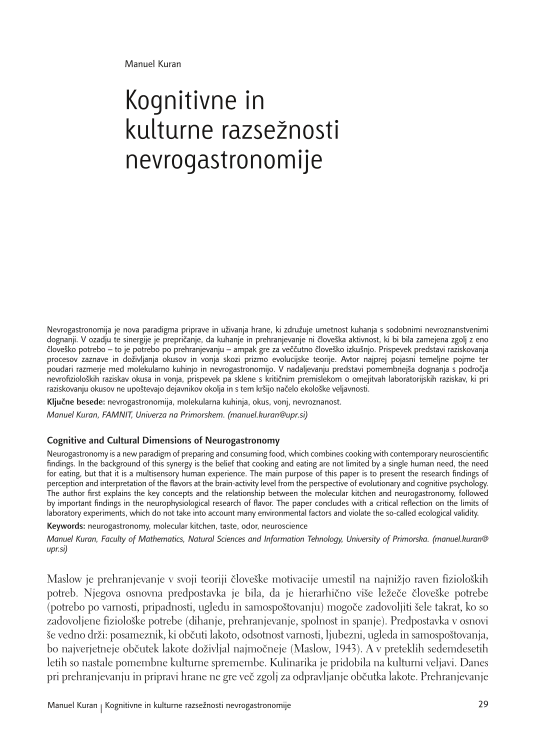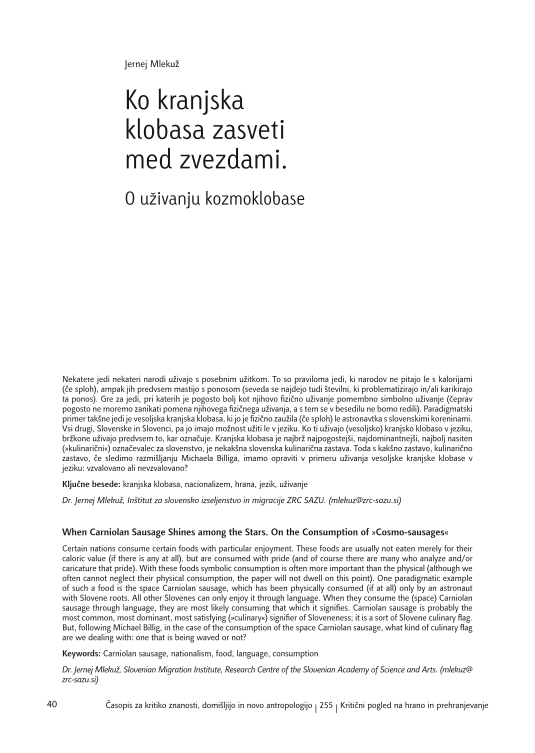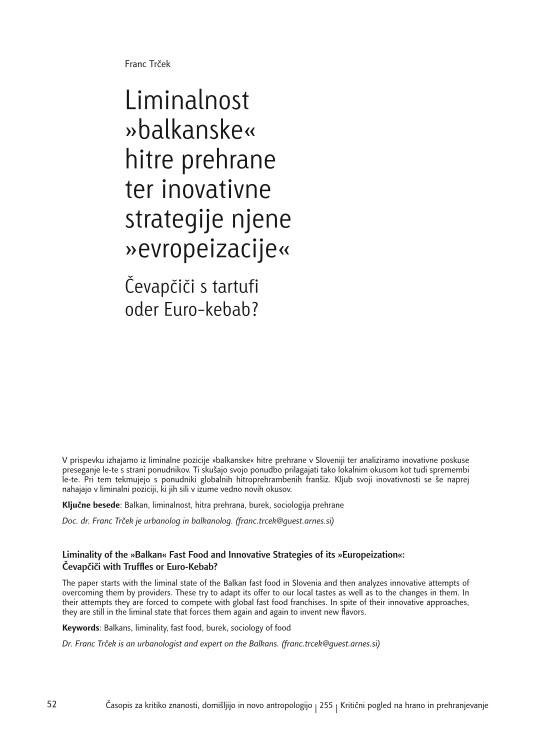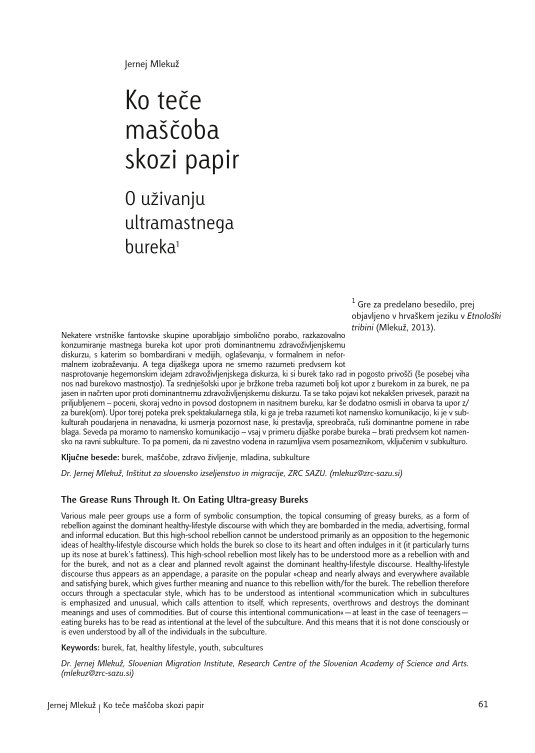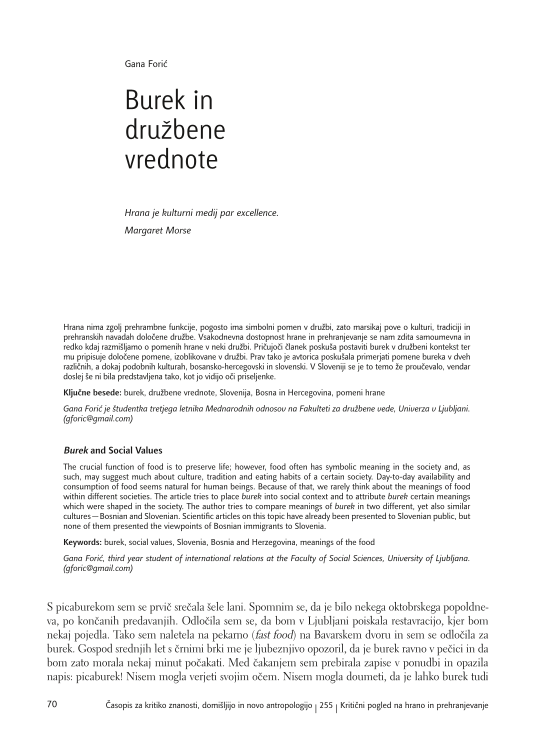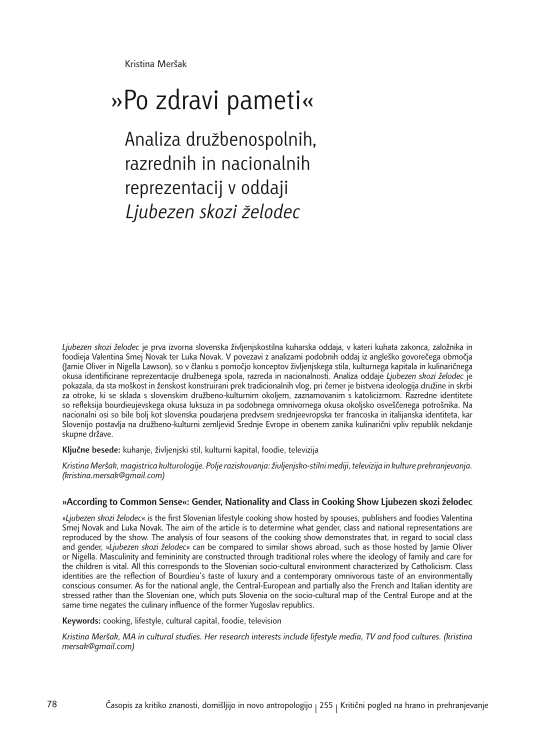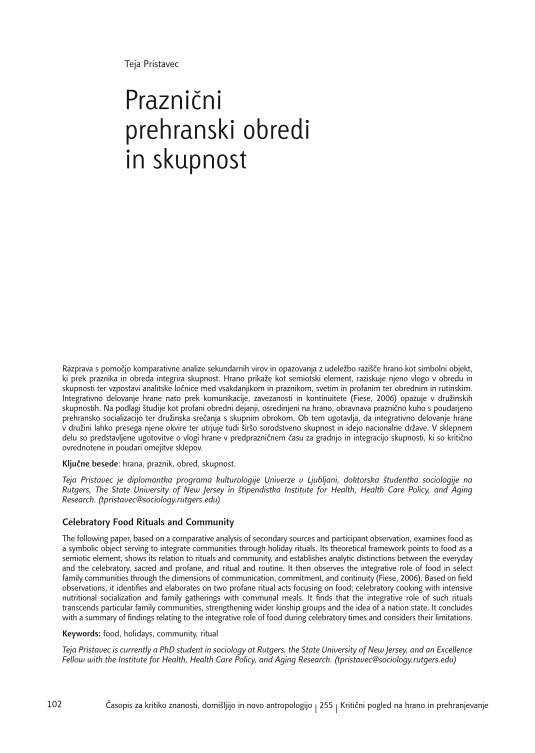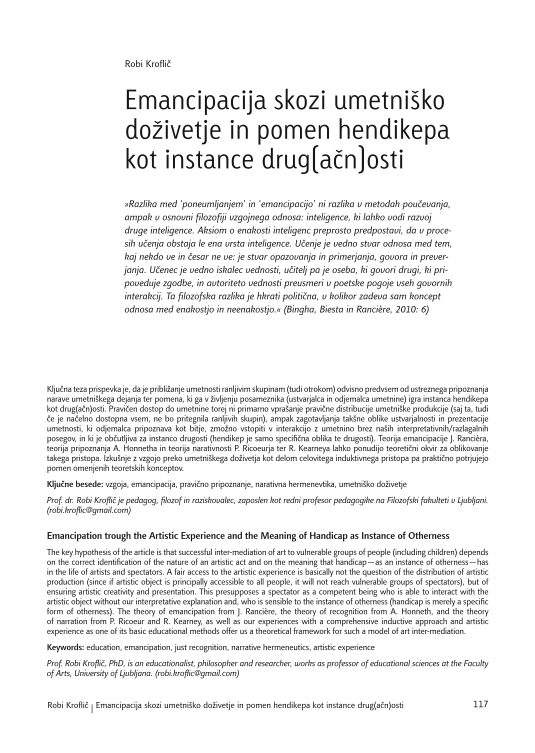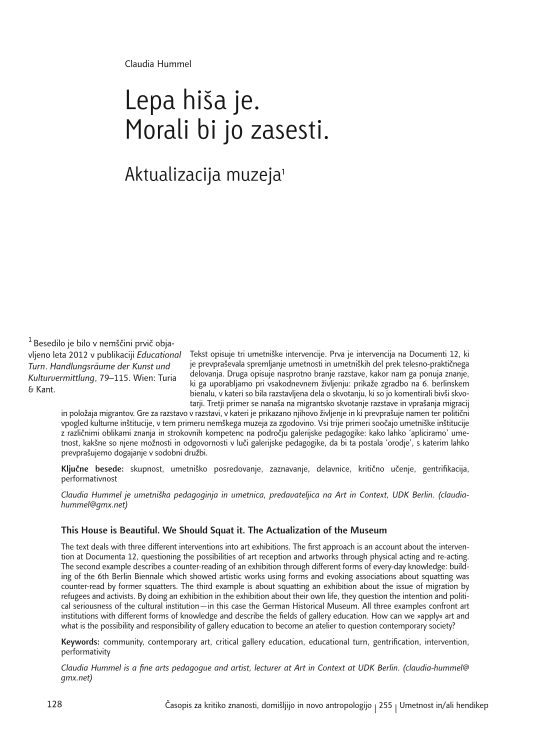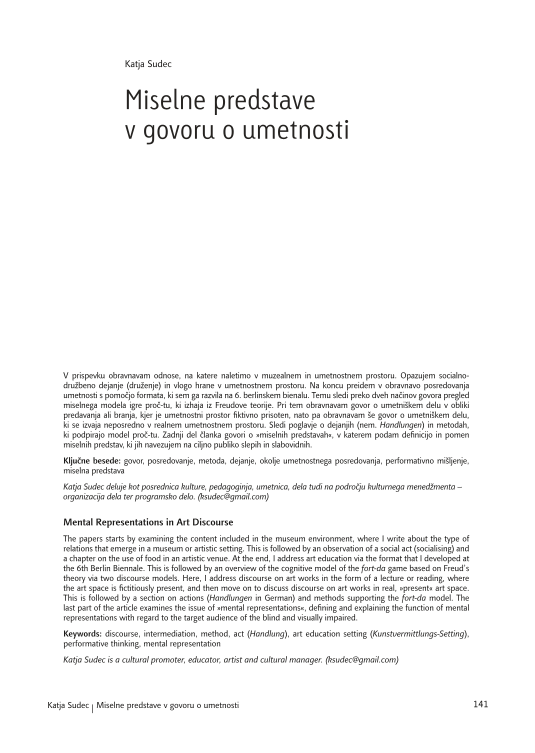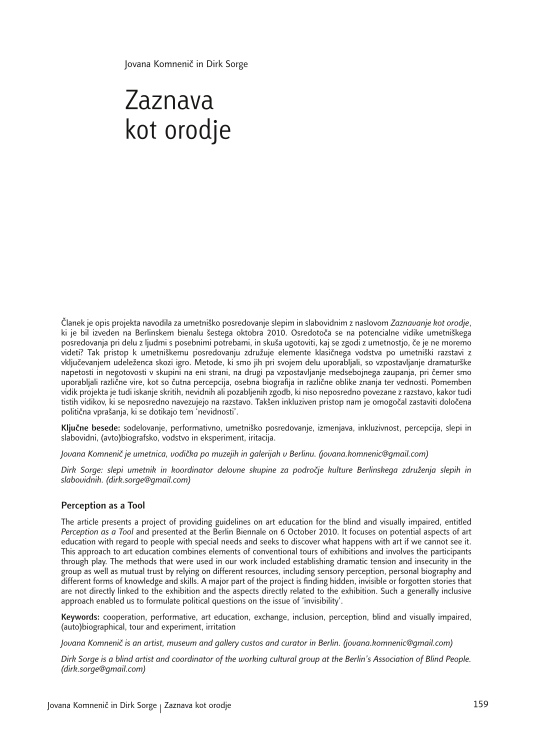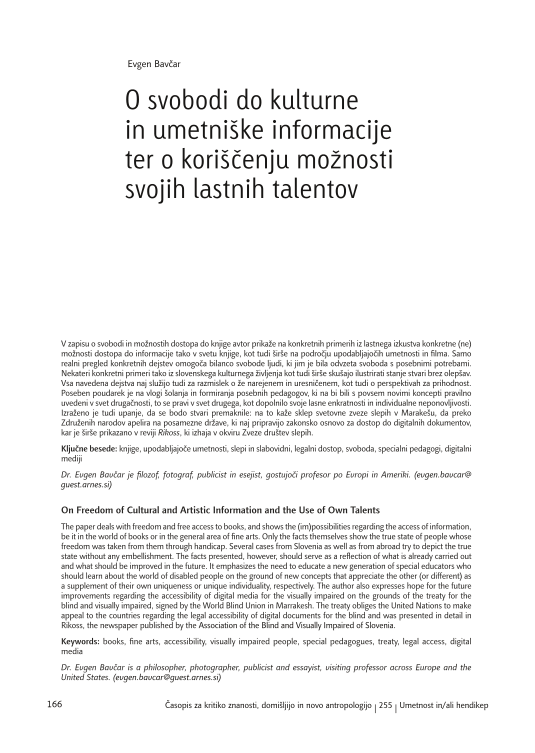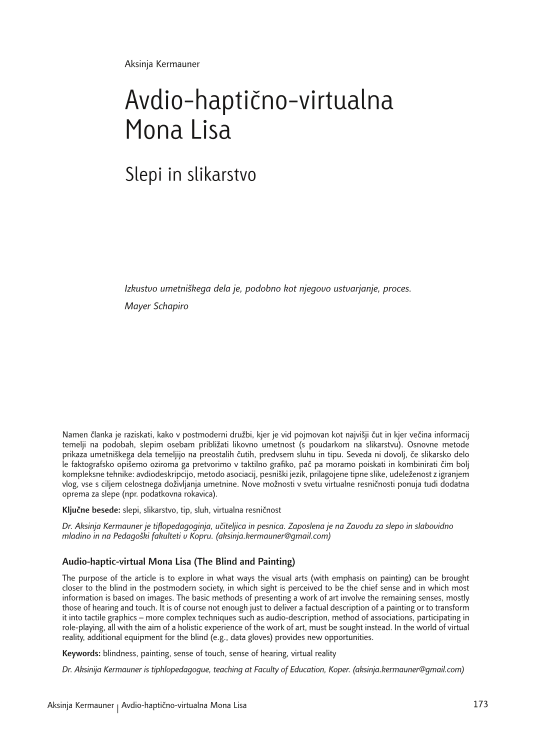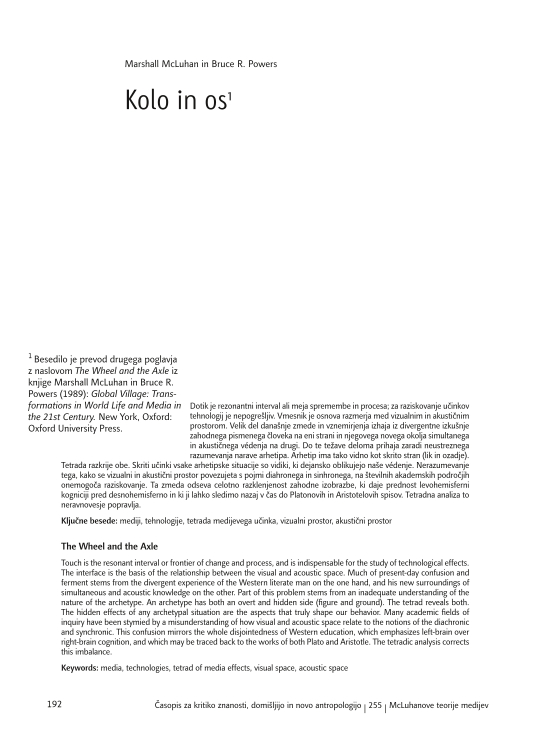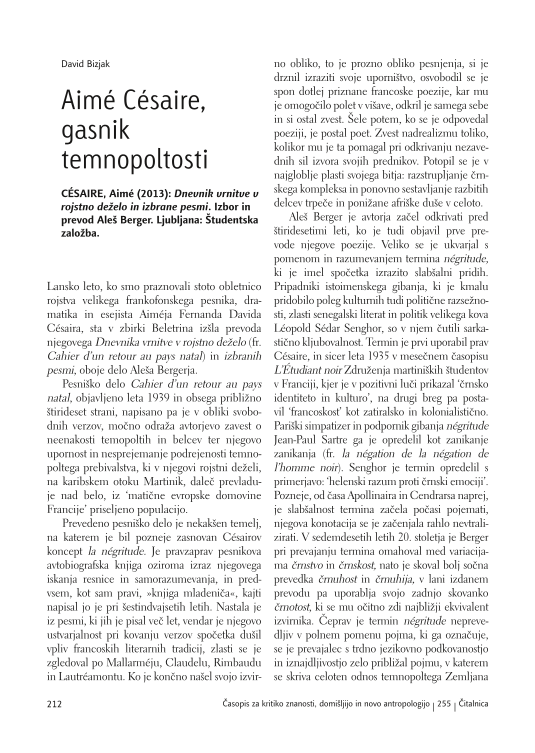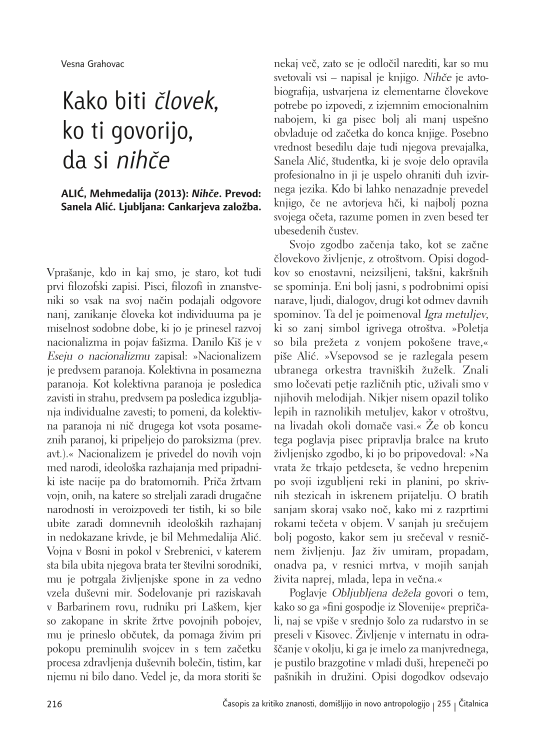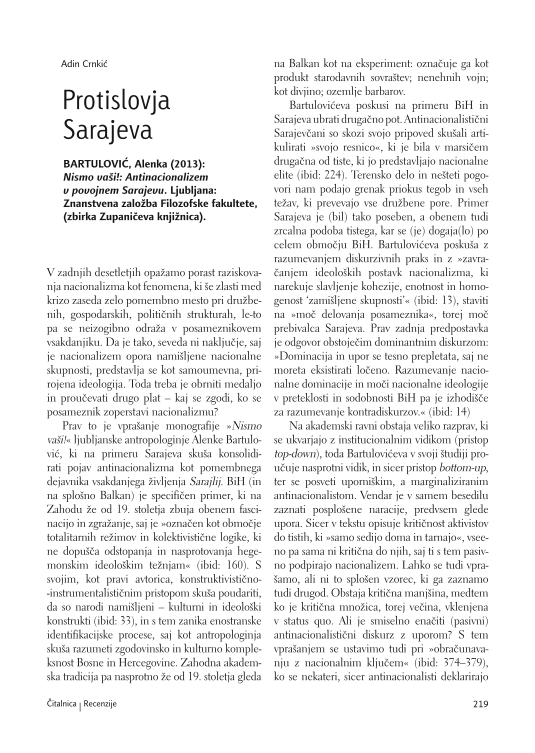Rezultat teoretskega brbotanja pričujoče številke je široko inter- in multidisciplinarno razumevanje hrane in prehranjevanja, ki presega zgolj ozko dimenzijo hrane kot goriva za telo. Hrana v takšni ali drugačni obliki je brez dvoma nujna za preživetje, vendar še zdaleč ni samo to. To dejstvo je očitno že pri višje razvitih sesalcih, kaj šele človeku. Zgovoren primer so kiti ubijalci (orke), ki občasno napadajo mladiče sivih kitov. Orke kite lovijo v manjših dobro koordiniranih skupinah z jasno začrtano strategijo, ki je plod naučenega vedenja in prenašanja znanja iz generacije v generacijo. Mladiča sivega kita z ukano najprej ločijo od precej večje in zaščitniške mame. Lov lahko traja tudi do šest ur in je za orke izjemno nevaren. Poleg tega pri njem porabijo ogromno energije. Kljub velikim tveganjem in naporom in kljub dejstvu, da je meso mladega sivega kita užitno, praviloma orke pojejo zgolj delikateso: kitov jezik in mehko spodnjo čeljust.
Ta razmeroma krut primer nazorno govori o tem, da pri hrani in prehranjevanju že v živalskem svetu ne gre samo za zadovoljevanje bioloških potreb, temveč za tesno prepletenost s kulturo. Kako izbiramo, dojemamo, presojamo, pripravljamo, kuhamo, shranjujemo, uživamo, prebavljamo in izločamo hrano se vedno dogaja v kontekstu kulture ter se izraža na kulturno specifične načine. Telesa, s katerimi izkušamo hrano v tem smislu niso zgolj fizična, statična in nespremenljiva ampak čutna in čuteča, prevodna in odprta zunanjosti, vedno v procesu (pre)oblikovanja in nedokončana. Preko stika s hrano naša telesa kažejo, da sta narava in kultura neločljivo povezani in soobstajata v kompleksnih razmerjih, ki so spremenljiva in fluidna. Hrano in prehranjevanje razumemo na presečišču biologije in nabora kulturnih pomenov, izkušenj in praks, ki jih ljudje v določenem kulturnem in socialnem kontekstu uporabljajo v povezavi s produkcijo, potrošnjo in izkušnjo hrane in prehranjevanja. Slednjega obravnavamo v najširšem smislu kot živeto kulturo, ki ima pomembno mesto v horizontu vsakdanjega življenja ljudi in njihovega osmišljevanja sveta: od receptov, kulinarične tradicije in kuharskih tehnik do prehrambene industrije, političnih in zdravstvenih lobijev ter medijev.
Lingvistika nas je udomačila v rabi konceptov, kot sta »minimalna samoglasniškost« in »minimalna soglasniškost«, ki referirata na tako elementaren sistem opozicij med fonemi, da ga predpostavlja malodane vsak znani ali nepoznani jezik; dejansko so to prve opozicije, ki se pojavijo v otrokovem jeziku, in zadnje, ki izginejo v govoru ljudi z določenimi afazičnimi motnjami.
Koncepta si sploh nista tako zelo različna, kajti – če sledimo lingvistiki – vsak jezik je konec koncev sestavljen ravno iz tovrstne fundamentalne opozicije med samoglasnikom in soglasnikom. Nadaljnja distinkcija med samoglasniki in soglasniki rezultira iz aplikacije distinkcij, ki so izpeljane iz drugih kontrastov, denimo visoko in razpršeno, odprto in zaprto, naglašeno in nenaglašeno.
V vseh jezikih sveta kompleksni sistemi opozicije med fonemi potemtakem ne počnejo ničesar drugega razen elaboracije preprostejšega sistema, ki je skupen vsem, v multiple smeri: kontrast med samoglasnikom in soglasnikom, po vpeljavi dvojne opozicije med visokim in razpršenim, naglašenim in nenaglašenim, proizvede po eni strani tako imenovani »samoglasniški trikotnik« (a, i, u), po drugi pa »soglasniški trikotnik« (k, p, t).
What can psychoanalysis tell us about food and eating? It begins with Freud, usually with the articulation of hunger (appetite) as a basic food instinct by analogy with the sexual drive (libido), and continues with the civilizing of appetite and cultural thinking about diets (ways of eating). If these debates on instinct and sexuality are fundamental for the civilizing of appetite, the latter process is shown as key in the formation of one’s ‘relationship’ to food. Civilizing of appetite and the (culturally determined) incorporation of food do not only form a primary relationship with the nutritious aspect of food, but also generate modes of enjoyment and non-enjoyment in food. The secondary approach, which is considering food through the instrumentation of needs, desires and fantasies, is the only one that really makes an in-depth understanding of the place and value of food, in both psychical and social registry. It is necessary not to forget that the market-capitalist environment is the one that increasingly imposes rules of consumption and daily diets. Each new food experience turns out to be favorable or unfavorable beyond the mere fact that the gratification of appetite does not (necessarily) mean the gratification of appetite desires. Therefore, enjoying food becomes a modality of politics: on the one hand, the politics of flavors and, on the other hand, the politics of market and products. Since food and eating are political, and they work as a particular ideology that codetermines »what to eat and drink« it is inevitable that psycho-culinary meets the concept of identity, which persists in the saying »I am what I eat.«
Neurogastronomy is a new paradigm of preparing and consuming food, which combines cooking with contemporary neuroscientific findings. In the background of this synergy is the belief that cooking and eating are not limited by a single human need, the need for eating, but that it is a multisensory human experience. The main purpose of this paper is to present the research findings of perception and interpretation of the flavors at the brain-activity level from the perspective of evolutionary and cognitive psychology. The author first explains the key concepts and the relationship between the molecular kitchen and neurogastronomy, followed by important findings in the neurophysiological research of flavor. The paper concludes with a critical reflection on the limits of laboratory experiments, which do not take into account many environmental factors and violate the so-called ecological validity.
Certain nations consume certain foods with particular enjoyment. These foods are usually not eaten merely for their caloric value (if there is any at all), but are consumed with pride (and of course there are many who analyze and/or caricature that pride). With these foods symbolic consumption is often more important than the physical (although we often cannot neglect their physical consumption, the paper will not dwell on this point). One paradigmatic example of such a food is the space Carniolan sausage, which has been physically consumed (if at all) only by an astronaut with Slovene roots. All other Slovenes can only enjoy it through language. When they consume the (space) Carniolan sausage through language, they are most likely consuming that which it signifies. Carniolan sausage is probably the most common, most dominant, most satisfying (»culinary«) signifier of Sloveneness; it is a sort of Slovene culinary flag. But, following Michael Billig, in the case of the consumption of the space Carniolan sausage, what kind of culinary flag are we dealing with: one that is being waved or not?
The paper starts with the liminal state of the Balkan fast food in Slovenia and then analyzes innovative attempts of overcoming them by providers. These try to adapt its offer to our local tastes as well as to the changes in them. In their attempts they are forced to compete with global fast food franchises. In spite of their innovative approaches, they are still in the liminal state that forces them again and again to invent new flavors.
Various male peer groups use a form of symbolic consumption, the topical consuming of greasy bureks, as a form of rebellion against the dominant healthy-lifestyle discourse with which they are bombarded in the media, advertising, formal and informal education. But this high-school rebellion cannot be understood primarily as an opposition to the hegemonic ideas of healthy-lifestyle discourse which holds the burek so close to its heart and often indulges in it (it particularly turns up its nose at burek’s fattiness). This high-school rebellion most likely has to be understood more as a rebellion with and for the burek, and not as a clear and planned revolt against the dominant healthy-lifestyle discourse. Healthy-lifestyle discourse thus appears as an appendage, a parasite on the popular »cheap and nearly always and everywhere available and satisfying burek, which gives further meaning and nuance to this rebellion with/for the burek. The rebellion therefore occurs through a spectacular style, which has to be understood as intentional »communication which in subcultures is emphasized and unusual, which calls attention to itself, which represents, overthrows and destroys the dominant meanings and uses of commodities. But of course this intentional communication«—at least in the case of teenagers— eating bureks has to be read as intentional at the level of the subculture. And this means that it is not done consciously or is even understood by all of the individuals in the subculture.
The crucial function of food is to preserve life; however, food often has symbolic meaning in the society and, as such, may suggest much about culture, tradition and eating habits of a certain society. Day-to-day availability and consumption of food seems natural for human beings. Because of that, we rarely think about the meanings of food within different societies. The article tries to place burek into social context and to attribute burek certain meanings which were shaped in the society. The author tries to compare meanings of burek in two different, yet also similar cultures—Bosnian and Slovenian. Scientific articles on this topic have already been presented to Slovenian public, but none of them presented the viewpoints of Bosnian immigrants to Slovenia.
»According to Common Sense«: Gender, Nationality and Class in Cooking Show Ljubezen skozi želodec
(
»Ljubezen skozi želodec« is the first Slovenian lifestyle cooking show hosted by spouses, publishers and foodies Valentina Smej Novak and Luka Novak. The aim of the article is to determine what gender, class and national representations are reproduced by the show. The analysis of four seasons of the cooking show demonstrates that, in regard to social class and gender, »Ljubezen skozi želodec« can be compared to similar shows abroad, such as those hosted by Jamie Oliver or Nigella. Masculinity and femininity are constructed through traditional roles where the ideology of family and care for the children is vital. All this corresponds to the Slovenian socio-cultural environment characterized by Catholicism. Class identities are the reflection of Bourdieu’s taste of luxury and a contemporary omnivorous taste of an environmentally conscious consumer. As for the national angle, the Central-European and partially also the French and Italian identity are stressed rather than the Slovenian one, which puts Slovenia on the socio-cultural map of the Central Europe and at the same time negates the culinary influence of the former Yugoslav republics.
The layer cake from Prekmurje—gibanica—is not merely a culinary specialty. It is an immaterial culturological content moving through its physical space. The phenomenon of gibanica marks modern Slovenes at least from the 1980s onwards and was deployed as an important medium of the Slovene ethno-national emancipation and the prospect of independence. Apart of other implications, we established a working hypothesis wherein the gibanica personifies severe problems of nativeness as one of crucial implications of contemporary mono-layered societal stratification in Slovenia. Applying comparative analysis of various regional and ethno-linguistic indicators, we confirmed the initial hypothesis and, furthermore, ascertained that gibanica managed to operate not only as a regional predictor but as a social-status predictor as well. From a local class-related dessert, it evolved into a pastry of the entire population of Prekmurje only after WWII. Whereas the emergence of the recipe of the cake is not known precisely, it may be placed somewhere into the 19th century and put together with the Jewish settlement in the Prekmurje region. Today, gibanica, so much different from the layer cake of Prlekija, represents the non-negotiable boundary of the Sloveneness towards the Croatianness despite the common geographical and cultural origin.
The following paper, based on a comparative analysis of secondary sources and participant observation, examines food as a symbolic object serving to integrate communities through holiday rituals. Its theoretical framework points to food as a semiotic element, shows its relation to rituals and community, and establishes analytic distinctions between the everyday and the celebratory, sacred and profane, and ritual and routine. It then observes the integrative role of food in select family communities through the dimensions of communication, commitment, and continuity (Fiese, 2006). Based on field observations, it identifies and elaborates on two profane ritual acts focusing on food; celebratory cooking with intensive nutritional socialization and family gatherings with communal meals. It finds that the integrative role of such rituals transcends particular family communities, strengthening wider kinship groups and the idea of a nation state. It concludes with a summary of findings relating to the integrative role of food during celebratory times and considers their limitations.
Umetnost kot panoga deluje v širšem družbenem kontekstu, ki se usmerja na delovanje znotraj specifičnega okolja. Okolja, ki pogojuje ekonomske, politične, socialne, vzgojne in družbene danosti skupine ali posameznika. Okolje, ki omogoča in pogojuje ter hkrati onemogoča (hendikepira).
Znotraj tega se umetnost orientira in deluje najprej v lastnem, kasneje širšem družbenem sistemu. Vsekakor ni sama sebi namen, ampak želi in se mora povezovati z družbo oziroma družbenim okoljem. Kot najsvobodnejša panoga bi naj bila dovolj emancipirana, da poda vse in še več. Je sposobna tudi sprejeti vse in še več? Vsakogar? Na kak način lahko deluje znotraj dane družbe in kaj lahko ponudi?
Emancipation trough the Artistic Experience and the Meaning of Handicap as Instance of Otherness
(
The key hypothesis of the article is that successful inter-mediation of art to vulnerable groups of people (including children) depends on the correct identification of the nature of an artistic act and on the meaning that handicap—as an instance of otherness—has in the life of artists and spectators. A fair access to the artistic experience is basically not the question of the distribution of artistic production (since if artistic object is principally accessible to all people, it will not reach vulnerable groups of spectators), but of ensuring artistic creativity and presentation. This presupposes a spectator as a competent being who is able to interact with the artistic object without our interpretative explanation and, who is sensible to the instance of otherness (handicap is merely a specific form of otherness). The theory of emancipation from J. Rancière, the theory of recognition from A. Honneth, and the theory of narration from P. Ricoeur and R. Kearney, as well as our experiences with a comprehensive inductive approach and artistic experience as one of its basic educational methods offer us a theoretical framework for such a model of art inter-mediation.
The text deals with three different interventions into art exhibitions. The first approach is an account about the intervention at Documenta 12, questioning the possibilities of art reception and artworks through physical acting and re-acting. The second example describes a counter-reading of an exhibition through different forms of every-day knowledge: building of the 6th Berlin Biennale which showed artistic works using forms and evoking associations about squatting was counter-read by former squatters. The third example is about squatting an exhibition about the issue of migration by refugees and activists. By doing an exhibition in the exhibition about their own life, they question the intention and political seriousness of the cultural institution—in this case the German Historical Museum. All three examples confront art institutions with different forms of knowledge and describe the fields of gallery education. How can we »apply« art and what is the possibility and responsibility of gallery education to become an atelier to question contemporary society?
The papers starts by examining the content included in the museum environment, where I write about the type of relations that emerge in a museum or artistic setting. This is followed by an observation of a social act (socialising) and a chapter on the use of food in an artistic venue. At the end, I address art education via the format that I developed at the 6th Berlin Biennale. This is followed by an overview of the cognitive model of the fort-da game based on Freud’s theory via two discourse models. Here, I address discourse on art works in the form of a lecture or reading, where the art space is fictitiously present, and then move on to discuss discourse on art works in real, »present« art space. This is followed by a section on actions (Handlungen in German) and methods supporting the fort-da model. The last part of the article examines the issue of »mental representations«, defining and explaining the function of mental representations with regard to the target audience of the blind and visually impaired.
The article presents a project of providing guidelines on art education for the blind and visually impaired, entitled Perception as a Tool and presented at the Berlin Biennale on 6 October 2010. It focuses on potential aspects of art education with regard to people with special needs and seeks to discover what happens with art if we cannot see it. This approach to art education combines elements of conventional tours of exhibitions and involves the participants through play. The methods that were used in our work included establishing dramatic tension and insecurity in the group as well as mutual trust by relying on different resources, including sensory perception, personal biography and different forms of knowledge and skills. A major part of the project is finding hidden, invisible or forgotten stories that are not directly linked to the exhibition and the aspects directly related to the exhibition. Such a generally inclusive approach enabled us to formulate political questions on the issue of ‘invisibility’.
The paper deals with freedom and free access to books, and shows the (im)possibilities regarding the access of information, be it in the world of books or in the general area of fine arts. Only the facts themselves show the true state of people whose freedom was taken from them through handicap. Several cases from Slovenia as well as from abroad try to depict the true state without any embellishment. The facts presented, however, should serve as a reflection of what is already carried out and what should be improved in the future. It emphasizes the need to educate a new generation of special educators who should learn about the world of disabled people on the ground of new concepts that appreciate the other (or different) as a supplement of their own uniqueness or unique individuality, respectively. The author also expresses hope for the future improvements regarding the accessibility of digital media for the visually impaired on the grounds of the treaty for the blind and visually impaired, signed by the World Blind Union in Marrakesh. The treaty obliges the United Nations to make appeal to the countries regarding the legal accessibility of digital documents for the blind and was presented in detail in Rikoss, the newspaper published by the Association of the Blind and Visually Impaired of Slovenia.
The purpose of the article is to explore in what ways the visual arts (with emphasis on painting) can be brought closer to the blind in the postmodern society, in which sight is perceived to be the chief sense and in which most information is based on images. The basic methods of presenting a work of art involve the remaining senses, mostly those of hearing and touch. It is of course not enough just to deliver a factual description of a painting or to transform it into tactile graphics – more complex techniques such as audio-description, method of associations, participating in role-playing, all with the aim of a holistic experience of the work of art, must be sought instead. In the world of virtual reality, additional equipment for the blind (e.g., data gloves) provides new opportunities.
The paper presents the methodological approach of Marshall McLuhan to media research, known as the medium theory. The author initially presents the key concepts of the medium theory, including the tetrad of media effects as a tool for anticipating the cultural implications of technology, and proposes the hypothesis that McLuhan understood media as primarily epistemological interfaces. McLuhan’s methodological approach is then placed into a theoretical context, especially in comparison to other similar approaches (Benjamin, Flusser, Haraway). The last part of the paper presents the authors, building on McLuhan’s theory (Toronto School of Communication, Manovich), and the relevance of his research today.
Touch is the resonant interval or frontier of change and process, and is indispensable for the study of technological effects. The interface is the basis of the relationship between the visual and acoustic space. Much of present-day confusion and ferment stems from the divergent experience of the Western literate man on the one hand, and his new surroundings of simultaneous and acoustic knowledge on the other. Part of this problem stems from an inadequate understanding of the nature of the archetype. An archetype has both an overt and hidden side (figure and ground). The tetrad reveals both. The hidden effects of any archetypal situation are the aspects that truly shape our behavior. Many academic fields of inquiry have been stymied by a misunderstanding of how visual and acoustic space relate to the notions of the diachronic and synchronic. This confusion mirrors the whole disjointedness of Western education, which emphasizes left-brain over right-brain cognition, and which may be traced back to the works of both Plato and Aristotle. The tetradic analysis corrects this imbalance.
ARISTOTEL (2011): Retorika. Spremna beseda, komentar in prevod dr. Matej Hriberšek. Ljubljana: Šola retorike Zupančič & Zupančič (zbirka Traditio lampadis).
Pred kratkim je v slovenskem jeziku izšel prevod Aristotelovega dela Retorika, s čimer imamo v slovenščini poleg Aristotelovih logičnih spisov (Kategorije, Druge analitike), fizikalnih spisov (Fizika, O nebu, O nastajanju in propadanju, O duši), metafizičnih spisov (Metafizika), še dobršen nabor spisov iz t. i. področja praktične filozofije (Nikomahova etika, Politika, Poetika in Retorika).
Prevod Retorike je prevajalec Matej Hriberšek opremil z obsežno spremno besedo, ki vključuje vsebine o Aristotelu in njegovem času; Aristotelovem pisnem opusu; pregledu zgodovine grške retorike; podroben vsebinski povzetek Aristotelove Retorike (kjer najdemo tudi tematizacije časa nastanka Retorike, njenega vpliva na poznejšo misel, prevajanja, komentiranja) in pojasnitev nekaterih temeljnih pojmov retorike, kot so: entimem (enthýmema), prepričevanje, sredstvo prepričevanja (pístis), silogizem (syllogismós), tekmerion (tekmérion), topos (tópos) … Delo je poleg tega opremljeno z obsežnim komentarjem v obliki opomb, ki je po besedah prevajalca stvaren, filološki, zgodovinski in delno filozofski. Poleg tega pa vključuje tudi reference na mesta v Retoriki in na druga Aristotelova dela in dela drugih piscev. Na koncu prevoda najdemo še obsežno izbrano bibliografijo o Aristotelovi Retoriki, stvarno in imensko kazalo ter, kar je za vse tiste, ki se nameravajo podrobneje študijsko ukvarjati z Aristotelovo Retoriko še posebej pomembno, obsežen slovar pomembnejših grških izrazov. Tovrsten slovar namreč omogoča natančno sledenje prevajalčevemu delu. Edino kar pri tem slovarju morda pogrešamo, so reference na posamezna pomembnejša mesta, kjer je posamezen izraz uporabljen.
CÉSAIRE, Aimé (2013): Dnevnik vrnitve v rojstno deželo in izbrane pesmi. Izbor in prevod Aleš Berger. Ljubljana: Študentska založba.
Lansko leto, ko smo praznovali stoto obletnico rojstva velikega frankofonskega pesnika, dramatika in esejista Aiméja Fernanda Davida Césaira, sta v zbirki Beletrina izšla prevoda njegovega Dnevnika vrnitve v rojstno deželo (fr. Cahier d’un retour au pays natal) in izbranih pesmi, oboje delo Aleša Bergerja.
Pesniško delo Cahier d’un retour au pays natal, objavljeno leta 1939 in obsega približno štirideset strani, napisano pa je v obliki svobodnih verzov, močno odraža avtorjevo zavest o neenakosti temopoltih in belcev ter njegovo upornost in nesprejemanje podrejenosti temnopoltega prebivalstva, ki v njegovi rojstni deželi, na karibskem otoku Martinik, daleč prevladuje nad belo, iz ‘matične evropske domovine Francije’ priseljeno populacijo.
Prevedeno pesniško delo je nekakšen temelj, na katerem je bil pozneje zasnovan Césairov koncept la négritude. Je pravzaprav pesnikova avtobiografska knjiga oziroma izraz njegovega iskanja resnice in samorazumevanja, in predvsem, kot sam pravi, »knjiga mladeniča«, kajti napisal jo je pri šestindvajsetih letih. Nastala je iz pesmi, ki jih je pisal več let, vendar je njegovo ustvarjalnost pri kovanju verzov spočetka dušil vpliv francoskih literarnih tradicij, zlasti se je zgledoval po Mallarméju, Claudelu, Rimbaudu in Lautréamontu. Ko je končno našel svojo izvirno obliko, to je prozno obliko pesnjenja, si je drznil izraziti svoje uporništvo, osvobodil se je spon dotlej priznane francoske poezije, kar mu je omogočilo polet v višave, odkril je samega sebe in si ostal zvest. Šele potem, ko se je odpovedal poeziji, je postal poet. Zvest nadrealizmu toliko, kolikor mu je ta pomagal pri odkrivanju nezavednih sil izvora svojih prednikov. Potopil se je v najgloblje plasti svojega bitja: razstrupljanje črnskega kompleksa in ponovno sestavljanje razbitih delcev trpeče in ponižane afriške duše v celoto.
ALIĆ, Mehmedalija (2013): Nihče. Prevod: Sanela Alić. Ljubljana: Cankarjeva založba.
Vprašanje, kdo in kaj smo, je staro, kot tudi prvi filozofski zapisi. Pisci, filozofi in znanstveniki so vsak na svoj način podajali odgovore nanj, zanikanje človeka kot individuuma pa je miselnost sodobne dobe, ki jo je prinesel razvoj nacionalizma in pojav fašizma. Danilo Kiš je v Eseju o nacionalizmu zapisal: »Nacionalizem je predvsem paranoja. Kolektivna in posamezna paranoja. Kot kolektivna paranoja je posledica zavisti in strahu, predvsem pa posledica izgubljanja individualne zavesti; to pomeni, da kolektivna paranoja ni nič drugega kot vsota posameznih paranoj, ki pripeljejo do paroksizma (prev. avt.).« Nacionalizem je privedel do novih vojn med narodi, ideološka razhajanja med pripadniki iste nacije pa do bratomornih. Priča žrtvam vojn, onih, na katere so streljali zaradi drugačne narodnosti in veroizpovedi ter tistih, ki so bile ubite zaradi domnevnih ideoloških razhajanj in nedokazane krivde, je bil Mehmedalija Alić. Vojna v Bosni in pokol v Srebrenici, v katerem sta bila ubita njegova brata ter številni sorodniki, mu je potrgala življenjske spone in za vedno vzela duševni mir. Sodelovanje pri raziskavah v Barbarinem rovu, rudniku pri Laškem, kjer so zakopane in skrite žrtve povojnih pobojev, mu je prineslo občutek, da pomaga živim pri pokopu preminulih svojcev in s tem začetku procesa zdravljenja duševnih bolečin, tistim, kar njemu ni bilo dano. Vedel je, da mora storiti še nekaj več, zato se je odločil narediti, kar so mu svetovali vsi – napisal je knjigo. Nihče je avtobiografija, ustvarjena iz elementarne človekove potrebe po izpovedi, z izjemnim emocionalnim nabojem, ki ga pisec bolj ali manj uspešno obvladuje od začetka do konca knjige. Posebno vrednost besedilu daje tudi njegova prevajalka, Sanela Alić, študentka, ki je svoje delo opravila profesionalno in ji je uspelo ohraniti duh izvirnega jezika. Kdo bi lahko nenazadnje prevedel knjigo, če ne avtorjeva hči, ki najbolj pozna svojega očeta, razume pomen in zven besed ter ubesedenih čustev.
BARTULOVIĆ, Alenka (2013): Nismo vaši!: Antinacionalizem v povojnem Sarajevu. Ljubljana: Znanstvena založba Filozofske fakultete, (zbirka Zupaničeva knjižnica).
V zadnjih desetletjih opažamo porast raziskovanja nacionalizma kot fenomena, ki še zlasti med krizo zaseda zelo pomembno mesto pri družbenih, gospodarskih, političnih strukturah, le-to pa se neizogibno odraža v posameznikovem vsakdanjiku. Da je tako, seveda ni naključje, saj je nacionalizem opora namišljene nacionalne skupnosti, predstavlja se kot samoumevna, prirojena ideologija. Toda treba je obrniti medaljo in proučevati drugo plat – kaj se zgodi, ko se posameznik zoperstavi nacionalizmu?
Prav to je vprašanje monografije »Nismo vaši!« ljubljanske antropologinje Alenke Bartulović, ki na primeru Sarajeva skuša konsolidirati pojav antinacionalizma kot pomembnega dejavnika vsakdanjega življenja Sarajlij. BiH (in na splošno Balkan) je specifičen primer, ki na Zahodu že od 19. stoletja zbuja obenem fascinacijo in zgražanje, saj je »označen kot območje totalitarnih režimov in kolektivistične logike, ki ne dopušča odstopanja in nasprotovanja hegemonskim ideološkim težnjam« (ibid: 160). S svojim, kot pravi avtorica, konstruktivistično-instrumentalističnim pristopom skuša poudariti, da so narodi namišljeni – kulturni in ideološki konstrukti (ibid: 33), in s tem zanika enostranske identifikacijske procese, saj kot antropologinja skuša razumeti zgodovinsko in kulturno kompleksnost Bosne in Hercegovine. Zahodna akademska tradicija pa nasprotno že od 19. stoletja gleda na Balkan kot na eksperiment: označuje ga kot produkt starodavnih sovraštev; nenehnih vojn; kot divjino; ozemlje barbarov.




